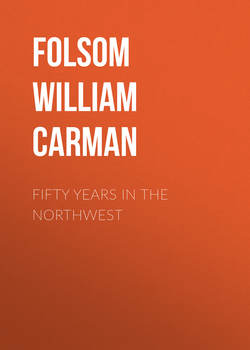Читать книгу Fifty Years In The Northwest - Folsom William Henry Carman - Страница 53
CHAPTER V.
BIOGRAPHIES
CLAYTON
ОглавлениеClayton includes township 33, range 15. The town was set off from Black Brook. The surface of a great part of the town is level and was originally marshy, but these marshes have been gradually drained, and fine farms and hay meadows have taken their place. The town was organized Nov. 10, 1875. The first supervisors were Morris De'Golier, Worthy Prentice and H. D. West. The first homestead entries were made in 1865 by Peter Bouchea and John McKay, a Frenchman, both Indian traders, who established a post at Marsh lake, but in six months abandoned it and never returned. The next settlers were Vandyke, Morehouse and Tanner, near the west line of the town, about 1870. The first improvements were made by Elam Greely in 1862, who dug a canal into Marsh lake to get water to float logs out of Beaver brook, thereby draining great tracts of swamp land. The laying of the North Wisconsin railroad track gave a fresh impetus to business, and conduced greatly to the building of the village of Clayton in section 24. The first sermon in the town of Clayton was preached by Rev. W. W. Ames, a Baptist; the first school was taught by S. M. De'Golier; the first store was opened by A. M. Wilcox, 1874. D. A. Humbird was the first postmaster. The North Wisconsin railway passes through the southeast part and the Minneapolis, Soo & Atlantic passes from the west side to the northeast corner of the town, and has a station, Gregory, in the west part.
Reuben F. Little was born June 13, 1839, in Topsham, Devonshire county, England. At ten years of age he began to care for himself, working for sixpence per week, carrying pottery in a moulding house. Before leaving England his wages had increased to three shillings per week. In the spring of 1853 he had saved three pounds sterling, and his grandfather gave him two pounds sterling. This five pounds paid his passage to Quebec and Montreal, where he got four dollars per month. Soon after he apprenticed himself for five years to learn the baker's and confectioner's trade at London, Upper Canada. Subsequently he took a homestead from the British government at Trading Lake, Upper Canada.
In the spring of 1861, at Detroit, Michigan, he enlisted in the United States infantry, regular army, and was promoted successively to first sergeant, to sergeant major, to second lieutenant, to first lieutenant. He resigned in September, 1865. During the war he served continuously in Gen. George H. Thomas' division, and took part in all the engagements under him, from Miles Springs, Kentucky, to Nashville, Tennessee. On the twenty-second of September, 1863, Mr. Little had the honor of being the last man to leave the Rossville Gap in front of Chattanooga after the disastrous fight of Chickamauga. He was wounded in the battle of Hoover's Gap and Smyrna, and at the siege of Corinth.
Mr. Little was married in 1865, and divorced in 1869, and re-married in St. Paul in 1878. He lost his Canada homestead, and took another homestead in Lincoln, Polk county, Wisconsin, in 1866. Afterward he went to St. Paul and became one of the firm of Little & Berrisford in the wholesale confectionery business. In 1879 he returned to Clayton, formerly part of Lincoln, and reclaimed a swamp of over six hundred acres, making it a productive meadow and tillage farm. Mr. Little has served several years as Clayton's town supervisor.
